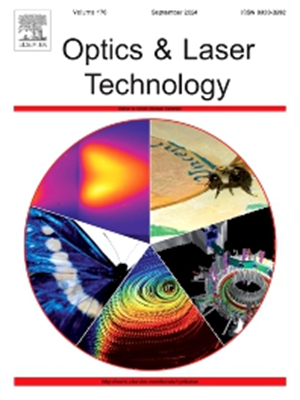In situ ablation of thin aluminum films for determination of targeted beam properties in picosecond laser-induced damage testing
IF 5
2区 物理与天体物理
Q1 OPTICS
引用次数: 0
Abstract
Accurate measurement of the targeted beam diameter is essential for a reliable quantification of the laser-induced damage threshold (LIDT), particularly for those tests requiring low-fluence levels. The targeted beam diameter is commonly obtained using a beam profiler located on the conjugate plane of the sample plane. Under special conditions such as vacuum conditions and oblique incidence in picosecond (ps) laser damage tests, the single dependence on the conjugate-plane beam profiler for beam diameter measurement demonstrates limitations. In this paper, the effects of aluminum (Al) film thickness, laser incidence angle, and vacuum conditions on the sample-plane beam diameter determination were first investigated for in situ metallic film ablation. Al film thickness (60–350 nm) and ablation depth showed negligible impact on beam diameter determination. The ablation evolves from a single outer circle to concentric inner and outer circles as the energy increases. The inner circle of 100–200 nm Al films was recommended for beam diameter determination due to its superior resistance to pedestal interference, and more stable ablation features. The experiment results demonstrate its applicability in both vacuum environment (5 × 10−4 Pa) and under oblique incidence (0°-70°). Furthermore, it enables identification of focal spot variations and can be used to ensure the targeted beam properties to maintain consistent beam properties in air and vacuum prior to each laser damage test. This parameter optimization approach provides a methodological framework for accurate beam diameter determination in ps-laser damage tests, which serves as a practical calibration reference for cross-laboratory and cross-instrument comparisons.
皮秒激光损伤试验中测定靶束特性的原位烧蚀铝薄膜
精确测量目标光束直径对于激光诱导损伤阈值(LIDT)的可靠量化至关重要,特别是对于那些需要低通量水平的测试。目标光束直径通常使用位于样品平面共轭平面上的光束剖面仪获得。在皮秒(ps)激光损伤试验中,在真空条件和斜入射等特殊条件下,单靠共轭平面光束廓形仪测量光束直径存在局限性。本文首先研究了铝膜厚度、激光入射角和真空条件对原位金属膜烧蚀样品-平面光束直径测定的影响。铝膜厚度(60 ~ 350 nm)和烧蚀深度对光束直径的影响可以忽略不计。随着能量的增加,烧蚀由单个外圆演变为内外同心圆。由于100 - 200nm的Al薄膜具有更好的抗基座干扰和更稳定的烧蚀特性,因此推荐内环作为光束直径的测定方法。实验结果表明,该方法适用于真空环境(5 × 10−4 Pa)和斜入射环境(0°-70°)。此外,它能够识别焦点光斑变化,并可用于确保目标光束特性在每次激光损伤测试之前在空气和真空中保持一致的光束特性。该参数优化方法为ps激光损伤试验中精确确定光束直径提供了方法框架,为跨实验室和跨仪器比较提供了实用的校准参考。
本文章由计算机程序翻译,如有差异,请以英文原文为准。
求助全文
约1分钟内获得全文
求助全文
来源期刊
CiteScore
8.50
自引率
10.00%
发文量
1060
审稿时长
3.4 months
期刊介绍:
Optics & Laser Technology aims to provide a vehicle for the publication of a broad range of high quality research and review papers in those fields of scientific and engineering research appertaining to the development and application of the technology of optics and lasers. Papers describing original work in these areas are submitted to rigorous refereeing prior to acceptance for publication.
The scope of Optics & Laser Technology encompasses, but is not restricted to, the following areas:
•development in all types of lasers
•developments in optoelectronic devices and photonics
•developments in new photonics and optical concepts
•developments in conventional optics, optical instruments and components
•techniques of optical metrology, including interferometry and optical fibre sensors
•LIDAR and other non-contact optical measurement techniques, including optical methods in heat and fluid flow
•applications of lasers to materials processing, optical NDT display (including holography) and optical communication
•research and development in the field of laser safety including studies of hazards resulting from the applications of lasers (laser safety, hazards of laser fume)
•developments in optical computing and optical information processing
•developments in new optical materials
•developments in new optical characterization methods and techniques
•developments in quantum optics
•developments in light assisted micro and nanofabrication methods and techniques
•developments in nanophotonics and biophotonics
•developments in imaging processing and systems

 求助内容:
求助内容: 应助结果提醒方式:
应助结果提醒方式:


